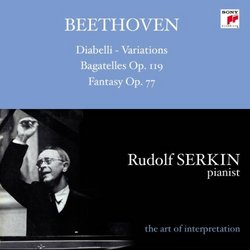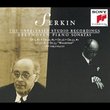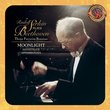| All Artists: Ludwig van Beethoven, Rudolf Serkin Title: Beethoven: Diabelli, Variation; Bagatelles, Op. 119; Fantasy, Op. 77 Members Wishing: 0 Total Copies: 0 Label: Sony Bmg Europe Original Release Date: 1/1/2003 Re-Release Date: 9/8/2003 Album Type: Import, Original recording remastered Genre: Classical Styles: Chamber Music, Forms & Genres, Fantasies, Historical Periods, Classical (c.1770-1830) Number of Discs: 1 SwapaCD Credits: 1 |
Search - Ludwig van Beethoven, Rudolf Serkin :: Beethoven: Diabelli, Variation; Bagatelles, Op. 119; Fantasy, Op. 77
 | Ludwig van Beethoven, Rudolf Serkin Beethoven: Diabelli, Variation; Bagatelles, Op. 119; Fantasy, Op. 77 Genre: Classical
|
Larger Image |
CD DetailsSimilar CDs |
CD ReviewsDo not agree with redgco J.Claude Paris | 05/31/2006 (5 out of 5 stars) "I do not agree with redgco(?): Tubeuf's liner notes do not aim at the music but at the musician and they are perfect at that;one can only congratulate Sony's editor for having a brilliant critic write about the musician:I am fed up with liner notes about the WOrks,.WE have encyclopedias for that, but too scarce stuff about the wonderful musicians of the 20 th century such as Serkin,Arrau, Kempf etc,not to mention Szell, Walter,etc.This record is a music work but also a music INTERPRETATION and I am glad that for once there is some to read abouthe INTERPRETER!" MUSIC HATH CHARMS DAVID BRYSON | Glossop Derbyshire England | 12/12/2007 (5 out of 5 stars) "However they are in very short supply in Beethoven's Diabelli variations. A more craggy, flinty, uningratiating masterpiece can rarely have been called into existence. Throughout my lifetime it has been associated with Rudolf Serkin more than with any other player to my knowledge. I have lived with his version for more years than I can now recall, and with another by Brendel - an early production of his, not a million miles distant from Serkin's in its concept of the work, before he formed his own more distinctive style, and I suspect quite possibly Serkin-influenced. I have never yet heard an account of the piece that quite equals Serkin's. The formidable technical demands are the common property of today's piano players. Preference as between this or that virtuoso's handling of this or that particular variation is likely to be an issue of the personal temperament of every individual listener. Even in the matter of controlling the work's overall structure and the handling of the contrasts between the variations, Serkin's characteristic alternations between rocketing velocity and hushed awestruck mystery, while unsurpassed and never likely to be surpassed, are not entirely unique. What marks out Serkin's Beethoven at its greatest is a quality that I can best call prophetic. He brings to Beethoven a peculiar sense of tension and electricity, largely but not entirely explicable by a special rhythmic instinct that was his own and nobody else's. What is it that distinguishes Serkin's playing of the rumbling left-hand sequences in the second variation from Brendel's? Nothing that is easy to pinpoint, but something that is not easy to mistake either. One learns to spot his special way with Beethoven's characteristic trick of dropping the volume on the first beat of a bar, where he has the knack of making a minute hesitation to let the resonance of the preceding note clear without seeming to, but for every such identifiable technique there are several that I do not expect ever to rationalise. There is something about his special tone-quality as well that makes him the natural interpreter of such a piece as this. It is not everyone's idea of `beautiful', not even mine, but it is never ugly or forced either, he never goes through his tone even in the most shattering fortissimo, and the whole effect is weighty without being heavy. The very start pleased me in particular by coming as near as I can ever recall on record to the elusive sound of Serkin in real life. His highly characteristic tone was hard to capture (if one can judge by results), and even this recording does not fully reproduce the enormous and startling crescendo that Serkin delivered in the left hand of Diabelli's theme. However, as I say, it gets more of the genuine and almost physical thrill than I can think of elsewhere of a great Serkin performance getting under way. I would not be without his Bagatelles op 119 either. These curious little masterpieces represent one particularly characteristic side of Beethoven, volatile, quirky and unpredictable. Here we are not short of choices. My own other version is by Kovacevich in one of his earlier incarnations as Stephen Bishop. If my choice were to be determined by these in particular, it would be a hard one. Serkin's playing is `cleaner', with less pedal, Bishop's warmer and more gemuetlich even in the threatening Scarbo-like sequences. There's not much in it for me. More than anything else my preference depends on the mood I'm in. There are two Sony discs of Serkin's Diabelli Variations circulating in Europe, and also now, it appears, in America. The one I strongly recommend is this one because in addition to the bagatelles it contains a neglected masterpiece, the G minor fantasia op 77. I have never seen the score of this, and I would like to know whether the variation-theme is really in a 4+3 7-beat, which is how it sounds to me. Never having heard anyone else play the piece I can recommend Serkin as unlikely to meet his match in it. He captures its moodiness to perfection, his unique sense of timing makes the stops and starts a delight to hear, the variation with the left-hand octaves is a terrific piece of Also Sprach Serkin, and the variation-theme and first variation are exquisite, which shows he can do that kind of thing too. Really exalted Beethoven-playing." A performance of great power, brilliance, and wit that does Craig Matteson | Ann Arbor, MI | 06/09/2008 (5 out of 5 stars) "I was fortunate to receive this glorious disk for Christmas. Yes, I am very late in reviewing it, but these variations (and the other two opus numbers) are so wonderful that I wanted to let them settle a bit more. Frankly, I am still trying to scale all its peaks.
David Bryson pointed me to this disk when we were exchanging notes on other performances of the Diabelli Variations. My complaint is that most recordings, even when played with technical brilliance, don't capture the wit of these variations. In my view, from that goofy little waltz theme on, this stuff is witty and is never meant to be played as if it were set in marble. The work is big, but meant to be huge fun. Mind you, I am not calling for slapstick or broad jokes (although the mock seriousness and pondering weight of the first variation is a pretty obvious clue about where we are going with the theme). Yes, it deserves its place right along side Bach's "Goldberg" variations as one of the sublime achievements of the variation form, but it does not partake of the same mood as Bach's great work. And one should not forget other great masters of the variation form such as Mendelssohn, Schumann, and Brahms. Serkin has the ability to play the work, and the mind to get the wit and fun right as well. He was a child prodigy who made his big debut when he was 12. Unlike most child wonders, he wasn't a flash in the pan who disappeared from the world stage once the novelty of youth wore off. He toured, recorded, and taught many lucky students at the Curtis Institute of Music for several decades. Serkin was also the son-in-law of the great violinist Adolph Busch and together, with a few others, they founded the Marlborough Music School and Festival in 1951 (in Vermont). While Serkin died in 1991, he remains one of the all time great pianists and young people should take the time to get to know his playing by listening to it closely and often. This disk should be one of those studied. The Diabelli Variations Op 120 comes from 1823 and is later than Beethoven's last piano sonata. In fact, except for the piano arrangement he made of the Grosse Fugue in 1826, it was his last piano composition to receive an opus number. It consists of a little theme by the music publisher and minor composer, Anton Diabelli. He circulated the theme in 1819 to leading Austrian composers of the day to be published together as a celebration of Austrian music and to raise money for the widows and orphans of soldiers of Austria lost during the Napoleonic Wars. Beethoven, for some unknown reason, decided to create a large set of variations and Diabelli ended up being one of the publishers of the work. The history of the publication and dedication of Beethoven's works is another interesting topic, but that is for another day. You should remember that Beethoven was completely deaf by this time and more than 50 years old. He only lived 56 years and a few months. This work of a theme with 33 variations usually takes more than 45 minutes to perform, which is longer than many multi-movement sonatas. Surely, the mature master didn't just string together a bunch of unrelated comments on a little waltz that the listener is supposed to absorb without connection or sense of structure. The fine musicologist, Karl Geiringer, offered a structural approach to the work that I like very much. You can find this article in the Oct 1964 edition of the Musical Quarterly (Vol. 50 No. 4 pp 496-503). Basically the work is bookended by the original Theme and Variation 33 (as an epilogue). The other 32 variations can be viewed in 8 groups of 4. Groups 1 and 2, 4 and 5, and 7 and 8 are paired, while groups 3 and 6 form episodes. More than that, as mentioned before the Theme and Variation 33 balance each other, and the other groups form a structure in that groups 1 and 8, groups 2 and 7, groups 3 and 6 (the episodes), and groups 4 and 5 and in balance and connected to each other. Geiringer's reasoning for all this makes interesting reading (if you are interested in this), and I cannot summarize it here. However, I think it is interesting to know that the mind of Beethoven did construct a perceivable structure for these variations to integrate them into a single great whole. The Bagatelles Op. 119 is also not performed enough. I think because it is more demanding than beginners can play, but somehow perceived as not substantial enough for concert artists. I am glad Serkin shows us differently. While these consist of works from different periods and purposes put together for publication purposes, they do sound well together and some are so short that they really can't be performed on their own. These have also been studied with articles on their various publications and where the pieces came from. It does appear that numbers 7-11 were originally written for Friedrich Starke's "Weiner Piano-Forte Schule" and were published in 1821. The first six were probably written in 1822. Beethoven offered the set of 11 to Peters, by they declined. Eventually they were published in various editions in Paris, St. Petersburg, Bonn (by Simrock), and Vienna (by Diabelli), and in London as "eleven pleasing pieces" by Clementi. There are differences that have been the object of academic study. See "The First Edition of Beethoven's Op. 119 Bagatelles" by Alan Tyson in the Musical Quarterly, Vol. 49 in No. 3 (July 1963) pp 331-338. The word Bagatelle refers to little trifles and compared to something like the "Diabelli Variations", these little pieces are slight. But Serkin reveals their intelligence and his playing gives them the sheen of small gems rather than the glitter of costume jewelry. The Fantasy in g minor, Opus 77 (the cover gets this right, but the back of the case calls it Opus 71 (which is a wind sextet) was written in 1809 and printed in 1810. The work is not performed very often, but deserves your attention. Beethoven and his fellow Viennese masters were noted for their brilliant improvisations. This fantasy shows all the marks of the improvisational style (brilliant runs and arpeggios, sudden tempo changes, a willingness to change key as the spirit moves, and so on). Obviously, Beethoven worked on this "improvisation", but I imagine it had its sources in his immense capacity for musical invention on the fly. The CD lists this work as being in g minor and it does start in that key, but it ends in B Major and the key is never listed in the printed title or in Thayer, so why don't we leave the key out of it and just call it the Op 77 fantasy. Serkin is brilliant in making the improvisation sound like his own. What a disk! Reviewed by Craig Matteson, Ann Arbor, MI " |

 Track Listings (36) - Disc #1
Track Listings (36) - Disc #1![Beethoven: Les 9 Symphonies [Box Set]](https://nationalbookswap.com/cd//m/16/0516/6140516.jpg)


